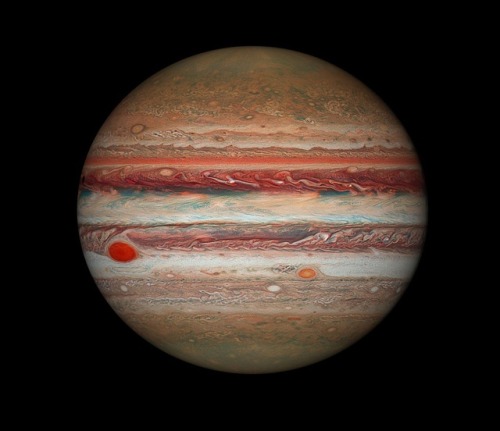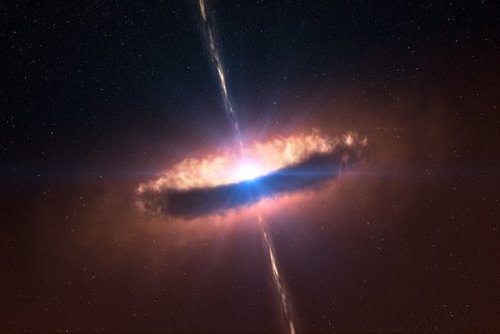Hubble’s Jupiter And The Shrinking Great Red Spot

Hubble’s Jupiter and the Shrinking Great Red Spot
Image Credit: NASA, ESA, Hubble, OPAL Program, STScI; Processing: Karol Masztalerz
More Posts from Riekod and Others
The Unreasonable Effectiveness of Mathematics in the Natural Sciences
Scholars have often expressed astonishment for how well mathematics works to describe our physical world. In 1960, Eugene Wigner published an article with the title above commenting that
…the mathematical formulation of the physicist’s often crude experience leads, in an uncanny number of cases, to an amazingly accurate description of a large class of phenomena.
Here are some others’ thoughts:
The most incomprehensible thing about the universe is that it is comprehensible.
— Albert Einstein
Physics is mathematical not because we know so much about the physical world, but because we know so little; it is only its mathematical properties that we can discover.
— Bertrand Russell
How can it be that mathematics, being after all a product of human thought which is independent of experience, is so admirably appropriate to the objects of reality?
— Albert Einstein
Our physical world doesn’t have just some mathematical properties, it has only mathematical properties.
— Max Tegmark
Physicists may have fallen prey to a false dichotomy between mathematics and physics. It’s common for theoretical physicists to speak of mathematics providing a quantitative language for describing physical reality… But maybe… math is more than just a description of reality. Maybe math is reality.
— Brian Greene
More info at https://en.wikipedia.org/wiki/The_Unreasonable_Effectiveness_of_Mathematics_in_the_Natural_Sciences

my type of meme

Lunar Eclipse 2019
Image Credit: Zachary Wells










The Surprising Reason Why Neutron Stars Don’t All Collapse To Form Black Holes
“The measurements of the enormous pressure inside the proton, as well as the distribution of that pressure, show us what’s responsible for preventing the collapse of neutron stars. It’s the internal pressure inside each proton and neutron, arising from the strong force, that holds up neutron stars when white dwarfs have long given out. Determining exactly where that mass threshold is just got a great boost. Rather than solely relying on astrophysical observations, the experimental side of nuclear physics may provide the guidepost we need to theoretically understand where the limits of neutron stars actually lie.”
If you take a large, massive collection of matter and compress it down into a small space, it’s going to attempt to form a black hole. The only thing that can stop it is some sort of internal pressure that pushes back. For stars, that’s thermal, radiation pressure. For white dwarfs, that’s the quantum degeneracy pressure from the electrons. And for neutron stars, there’s quantum degeneracy pressure between the neutrons (or quarks) themselves. Only, if that last case were the only factor at play, neutron stars wouldn’t be able to get more massive than white dwarfs, and there’s strong evidence that they can reach almost twice the Chandrasekhar mass limit of 1.4 solar masses. Instead, there must be a big contribution from the internal pressure each the individual nucleon to resist collapse.
For the first time, we’ve measured that pressure distribution inside the proton, paving the way to understanding why massive neutron stars don’t all form black holes.

Saturn’s rings and our planet Earth and Moon in the same frame captured by nasa’s Cassini spacecraft 19 July. (source @nasa) *Out Pale Blue Dot*







Amazing views from the International Space Station (ISS)




What is a protostar?
The formation of stars begins with the collapse and fragmentation of molecular clouds into very dense clumps. These clumps initially contain ~0.01 solar masses of material, but increase in mass as surrounding material is accumulated through accretion. The temperature of the material also increases while the area over which it is spread decreases as gravitational contraction continues, forming a more stellar-like object in the process. During this time, and up until hydrogen burning begins and it joins the main sequence, the object is known as a protostar.
This stage of stellar evolution may last for between 100,000 and 10 million years depending on the size of the star being formed. If the final result is a protostar with more than 0.08 solar masses, it will go on to begin hydrogen burning and will join the main sequence as a normal star. For protostars with masses less than this, temperatures are not sufficient for hydrogen burning to begin and they become brown dwarf stars.
Protostars are enshrouded in gas and dust and are not detectable at visible wavelengths. To study this very early stage of stellar evolution, astronomers must use infrared or microwave wavelengths.
Protostars are also known as Young Stellar Objects (YSOs).


M43 - Part of the same star-forming complex as the Great Orion Nebula (M42)

Pacific Ocean seen from Gemini 7
Credit: NASA
-
 jessystardust liked this · 2 months ago
jessystardust liked this · 2 months ago -
 manesalex reblogged this · 2 months ago
manesalex reblogged this · 2 months ago -
 horsesforhearts reblogged this · 2 months ago
horsesforhearts reblogged this · 2 months ago -
 countthelions liked this · 2 months ago
countthelions liked this · 2 months ago -
 eriond reblogged this · 2 months ago
eriond reblogged this · 2 months ago -
 oxbloodpsychedelia reblogged this · 2 months ago
oxbloodpsychedelia reblogged this · 2 months ago -
 propalahramota reblogged this · 2 months ago
propalahramota reblogged this · 2 months ago -
 propalahramota liked this · 2 months ago
propalahramota liked this · 2 months ago -
 1127am reblogged this · 3 months ago
1127am reblogged this · 3 months ago -
 asexualanders reblogged this · 3 months ago
asexualanders reblogged this · 3 months ago -
 improvinspi reblogged this · 3 months ago
improvinspi reblogged this · 3 months ago -
 mypopculturemoodblog reblogged this · 3 months ago
mypopculturemoodblog reblogged this · 3 months ago -
 kalonkakons reblogged this · 3 months ago
kalonkakons reblogged this · 3 months ago -
 messier47 reblogged this · 4 months ago
messier47 reblogged this · 4 months ago -
 yaoo-yxoo liked this · 4 months ago
yaoo-yxoo liked this · 4 months ago -
 stashbob reblogged this · 4 months ago
stashbob reblogged this · 4 months ago -
 fetabathwater reblogged this · 4 months ago
fetabathwater reblogged this · 4 months ago -
 augusteoak liked this · 5 months ago
augusteoak liked this · 5 months ago -
 sunaddicted liked this · 5 months ago
sunaddicted liked this · 5 months ago -
 sisterofreverance liked this · 5 months ago
sisterofreverance liked this · 5 months ago -
 tattoojunkiie liked this · 5 months ago
tattoojunkiie liked this · 5 months ago -
 trickstersmakethisworld reblogged this · 5 months ago
trickstersmakethisworld reblogged this · 5 months ago -
 everthehero reblogged this · 5 months ago
everthehero reblogged this · 5 months ago -
 therearenoowls liked this · 6 months ago
therearenoowls liked this · 6 months ago -
 wesleepinpairs liked this · 6 months ago
wesleepinpairs liked this · 6 months ago -
 theydiedtogether reblogged this · 6 months ago
theydiedtogether reblogged this · 6 months ago -
 artemissylvatica-blog liked this · 6 months ago
artemissylvatica-blog liked this · 6 months ago -
 mspillow liked this · 6 months ago
mspillow liked this · 6 months ago -
 karnival016 reblogged this · 6 months ago
karnival016 reblogged this · 6 months ago -
 staceyisnthere reblogged this · 6 months ago
staceyisnthere reblogged this · 6 months ago -
 finnickfoxes reblogged this · 6 months ago
finnickfoxes reblogged this · 6 months ago -
 splice-up liked this · 6 months ago
splice-up liked this · 6 months ago -
 snoopyhead98 reblogged this · 6 months ago
snoopyhead98 reblogged this · 6 months ago -
 peri-helia reblogged this · 6 months ago
peri-helia reblogged this · 6 months ago -
 earanie reblogged this · 6 months ago
earanie reblogged this · 6 months ago -
 earanie liked this · 6 months ago
earanie liked this · 6 months ago -
 opheliathegrey liked this · 6 months ago
opheliathegrey liked this · 6 months ago -
 marthajefferson reblogged this · 6 months ago
marthajefferson reblogged this · 6 months ago -
 billybatsonmylove liked this · 6 months ago
billybatsonmylove liked this · 6 months ago -
 tachvintlogic reblogged this · 6 months ago
tachvintlogic reblogged this · 6 months ago -
 bayoulou liked this · 6 months ago
bayoulou liked this · 6 months ago -
 versodile reblogged this · 6 months ago
versodile reblogged this · 6 months ago -
 panthaleia reblogged this · 6 months ago
panthaleia reblogged this · 6 months ago -
 importantmentalityphilosopher liked this · 6 months ago
importantmentalityphilosopher liked this · 6 months ago -
 reptilepolice reblogged this · 7 months ago
reptilepolice reblogged this · 7 months ago -
 reptilepolice reblogged this · 7 months ago
reptilepolice reblogged this · 7 months ago -
 panthaleia liked this · 7 months ago
panthaleia liked this · 7 months ago